Martin Harrison, G3USF & Steve Reed, G0AEV- Issue 62, August 1999
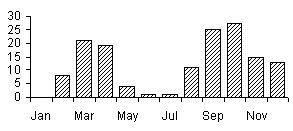 |
Predicting six metre DX openings is the current hot discussion topic. When will the band open to various parts of the world? And at what times of the day will these openings be most likely to occur? Looking back at results from previous cycles is the only guide available for openings to many parts of the world, but for propagation between Africa and Europe we can extrapolate from data collected last year. These data will serve as a good guide to what we can expect in 1999: the date-time patterns should hold even though we expect absolute activity levels will be higher, as results from the early part of the year have already started to show. The data used in this analysis were extracted from the Six and Ten Reports for 1998, and consists of the number of 50MHz Africa-Europe openings that occurred in each month and for each hour of the day grouped by broad sub-continental areas. Grouping was done for simplicity, and because there is insufficient data from individual African countries. The areas are ‘Southern Africa’ (ZS, V5, 7Q, Z2, A2), ‘Equatorial/West Africa’ (C5, 3C, TL, TR, TT, 9G), ‘Mediterranean Europe’ (European countries bordering the Mediterranean plus Portugal) and ‘Northern Europe’ (UK included). Data for France was excluded as being both ‘Mediterranean’ and ‘North’. When interpreting the results, note that ‘Northern Europe’ includes some countries more favourably located than the UK for TEP openings. The data presented in the first set of graphs (figures 1a, 1b, 2a, 2b) is the reported number of days per month that propagation occurred between these areas. The Mediterranean countries experienced significantly more propagation, especially at the equinoxes, which is the pattern expected for the F layer. The story is not so clear for Northern Europe where the relatively high number of mid-summer openings probably reflects the influence of sporadic E. With higher levels of ionisation in 1999, Northern Europe may expect to have relatively more openings at the Equinoxes, perhaps similar to that for the Med. in 1998. The second set of graphs (figures 3a, 3b, 4a, 4b) shows the times of openings. The patterns are again those expected for F layer propagation (including TEP), and are much the same for both parts of Europe. However the southern part of Europe saw many more openings: note that the Y-axis scales of the graphs are different! 17.00 to 18.00 is clearly the best time to catch openings to Southern Africa. It less easy to pick a single best time for West and Equatorial Africa as the peak times for openings vary more with season, as discussed below. The seasonal variations in peak times for openings are quite interesting. To get a meaningful sample to show this, the data has been grouped in a slightly different way. Peak hour distributions for the two parts of Europe are similar, so all data for Europe has been amalgamated in a single continental area. ‘Equivalent month pairs’ have been used, which means combining data for pairs of months with the same relative position in the year (February and November, March and October, etc). The result of this is shown in figures 5a and 5b. Peak hour is plotted on the X-axis and the average number of days per month when propagation was reported on the Y-axis. The graphs show, for example, that the best time for contacts between Europe and West/Equatorial Africa in January or December should be at 10z but the number of days when propagation occurs is small. March/October has the best chance of openings with peak times slightly earlier (15z) for West/Equatorial Africa than (17z) Southern Africa. Peak times are early in the day for winter openings, late in the day for summer openings. An exception is June/July to West/Equatorial Africa, which is probably due to ‘sporadic’ E. The spread of peak times is much less for Southern Africa with 17z being the peak time for contacts for most months of the year. (Edited from the Six and Ten Report, January 1999. Information on the 6 & 10 Report from G0AEV (QTHR, e-mail g0aev@explore.force9.co.uk, or check http://homepages.force9.net/explore/6and10/)
|
| Figure 1a: Days per month with propagation, Equatorial / West Africa - Mediterranean Europe. | |
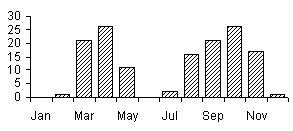 |
|
| Figure 1b: Days per month with propagation, Southern Africa - Mediterranean Europe. | |
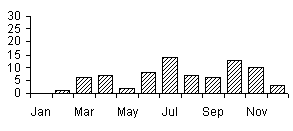 |
|
| Figure 2a: Days per month with propagation, Equatorial / West Africa - Northern Europe. | |
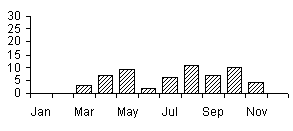 |
|
| Figure 2b: Days per month with propagation, Sputhern Africa - Northern Europe. | |
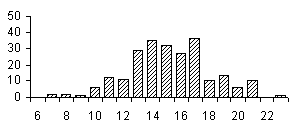 |
|
| Figure 3a: Times of openings, Equatorial / West Africa - Mediterranean Europe. | |
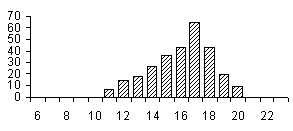 |
|
| Figure 3b: Times of openings, Southern Africa - Mediterranean Europe. | |
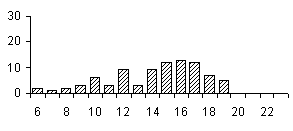 |
|
| Figure 4a: Times of openings, Equatorial / West Africa - Northern Europe. | |
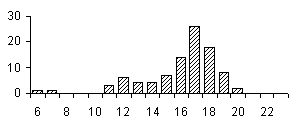 |
|
| Figure 4b: Times of openings, Southern Africa - Northern Europe. | |
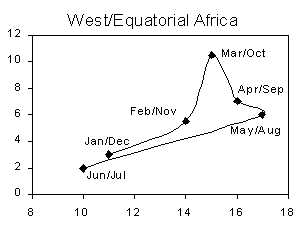 |
|
| Fig 5a: Peak times for West / Equatorial Africa - Europe. | |
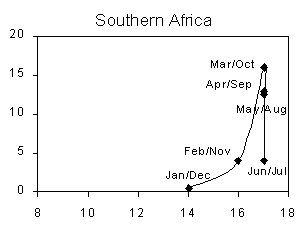 |
|
| Fig 5b: Peak times for Southern Africa - Europe. |